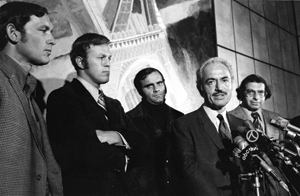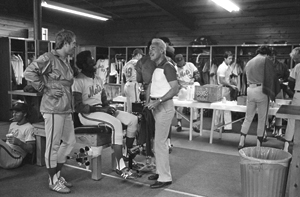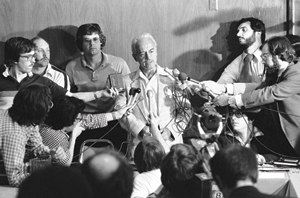When Marvin Miller, who led the MLB Players Association from its inception in 1966 until 1982, died Nov. 27 at the age of 95, sports labor lost a legendary figure. His successor at the MLBPA, Don Fehr, now the head of the NHL Players’ Association, eloquently summed up Miller’s importance to sports business when he accepted the Champion of Sports Business honor on Miller’s behalf at a March 2011 ceremony. Some of Fehr’s remarks on that day are presented here.
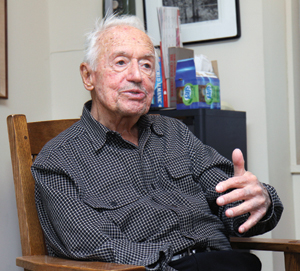 |
Miller giving an interview in 2011.
Photo by: PATRICK E. MCCARTHY
|
When I think about Marvin and what he accomplished I don’t actually think about specific milestones — there was this dispute, or that agreement negotiated or this benefit accomplished on behalf of the players. It’s something both more and different than that. But I think it’s clear that in his case he is the second half of the question, who are the two people in baseball in the 20th century without whose presence the game might have been the most different? I think in the first half of the 20th century, even though he was only there for four years, it was pretty clearly Jackie Robinson. And I think in the second half of the 20th century it was pretty clear that it was Marvin Miller.
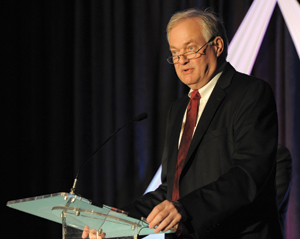 |
Don Fehr spoke about Marvin Miller in 2011.
Photo by: GORT PRODUCTIONS
|
He is still held in enormous regard. When people talk about the individual who created the icon of sports unions or of unions generally, his name usually is the first one mentioned. And while he was at the MLBPA for a long time, 16 1/2 years, he also left there more than 29 years ago. He created the model of not only what athlete unions should be, but in my judgment, what a union should be. He established an institution, the Major League Baseball Players Association, which has persevered during the 29 years since he retired and remains as strong and as vibrant as one could wish, almost entirely, in my view, because of the lessons and the structure that Marvin put in place during his tenure.
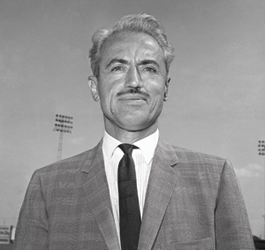 |
And the central point of the entire enterprise was to make sure that players understood — athletes much younger than he was, negotiating against individuals most often much older, much more experienced and much more well-educated in the traditional sense than they were — that the players could influence their own circumstances, they could have a large degree of control of their own future and that they could have confidence that they could accomplish that if they went about it in the right way.
You have to be in constant communication with your membership. Obviously you always tell them the truth, but you tell it to them bluntly. And that’s something that a lot of athletes and a lot of celebrities are not used to hearing. Second thing is that you educate them. Understanding how the sports business operates, baseball business operates, is not all that difficult, but you don’t actually pick it up by playing the game or by reading the newspapers.
You have to work at it a little bit. You have to make sure that the players are involved and that they participate in the activities of the organization. And most often that means being present and participating during the negotiations.
And I’ll tell you just one story about that, which taught me how true it was. In 1981, in the spring — this is before the strike began that year — we’re having negotiations and something occurred in which it was suggested that
what was being advanced by the players’ side was just something that a bunch of smart lawyers were talking about. Players didn’t really understand it, didn’t care about it and didn’t believe in it. And I’ll never forget this. Marvin stood up and he said, “Well, OK. If you think that’s true and you can get a better deal from the players, we will leave.” And with that, Marvin and I and one other young lawyer that was with us left, and left the negotiation to the players that were in the room.
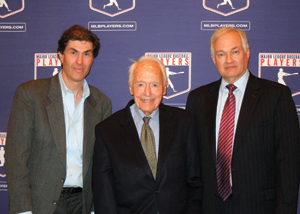 |
From top photo: Miller in 1966. With players, including Joe Torre (center), and Dick Moss (right) in 1972. Meeting with the Mets in 1980; strike press conference in 1981; and with MLBPA executive director Michael Weiner and Fehr in 2012.
Photos by: AP IMAGES
|
To have that level of confidence in your membership and to tell them that you have that level of confidence, I think tells you an awful lot about the organization that he built. As his remarks in the video suggested, solidarity does not come about by accident. Internal cohesion and consensus does not come about by accident. You have to work at it.
The last thing I would say, in that regard, was that you need to make sure the players understand that when it comes to union-management relations, they approach the owners not as supplicants and not as disposable employees, but as equals. That’s what the bargaining table is about. And if you can do that, you can succeed. And the respect and admiration that I think Marvin enjoys 29 years after he retired is a pretty good testament to the accomplishments that he had.
WHAT OTHERS ARE SAYING
“There are reasons why the sport has grown in the enormous way it has. But chief among them is the competition for players among franchises that has been fostered by free agency. Free agency is the greatest contribution to the success of baseball, far more than any other technique or invention, rule, discovery, whatever you want to call it. And Marvin is the man who understood that and dedicated his working life to achieving that.”
Gene Orza
Former MLBPA chief operating officer
“Marvin was a groundbreaker. Players of my era and the player of today should appreciate the benefits that resulted from Marvin’s leadership. He had a great way of communicating and relating the issues to us. I was proud to be one of the players that sat alongside him.”
Joe Torre
MLB executive vice president of baseball
operations and former MLB player
“You can’t really talk about the history of sports, the business of sports over the last 50 years without talking about the influence of Marvin.”
Michael Weiner
MLBPA executive director
“Most of all I think of Marvin as being a great teacher. He could explain things to people to make them understand without insulting them. He was a terrific leader of men.”
Dick Moss
Former MLBPA general counsel





